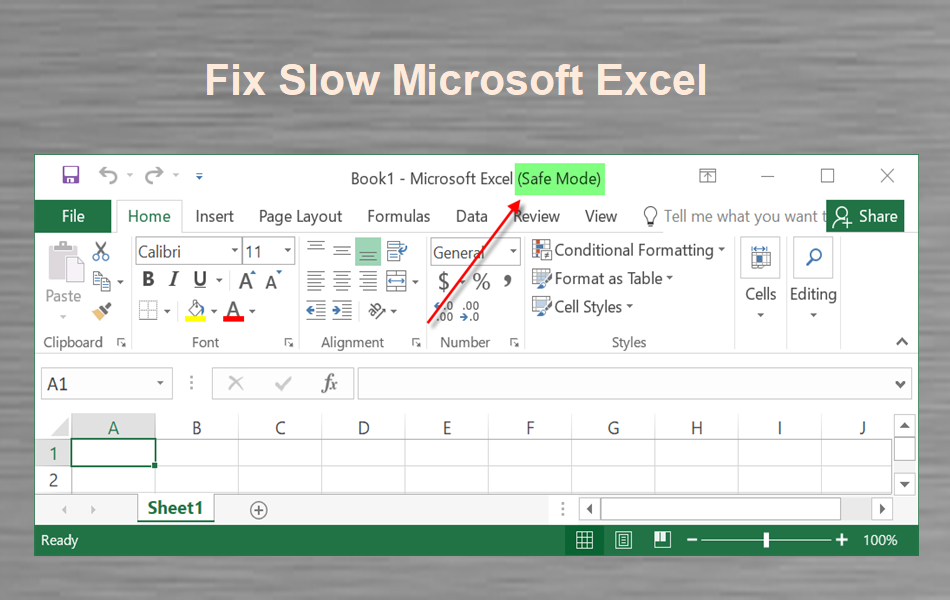Safe mode lets you start Excel without encountering certain startup programs. You can open Excel in safe mode by pressing and holding Ctrl while you start the program, or by using the /safe switch (excel.exe /safe) when you start the program from the command line. The Excel Safe mode is usually used for troubleshooting. It is used when you find that your Excel application is crashing every time you open a particular file, or after you installed some add-ins. Sometimes the issue may also be the result of certain.
Q: I am using Windows 7, and I have installed several Excel add-ins (Analysis ToolPak, Solver, PowerPivot, Power View, Inquire, and QuickBooks Excel Report Updater). Unfortunately, these add-ins make Excel launch much slower. I don’t always need to use these add-ins, so I’d like to know if there is a way to launch Excel without loading these add-ins so that it launches quicker. (Note: The QuickBooks Report Updater add-in the reader mentioned installs from QuickBooks when the Intuit Statement Writer is used for the first time.)
A: To launch Excel faster without loading any add-ins, use the Windows Run command, and be sure to add the “ /s” switch at the end of that command. Here’s how:
Launch the Windows Run dialog box in Windows 7 by selecting the Windows Start button, All Programs, Accessories, and Run. Then type excel /s (be sure to include the space) in the Run dialog box and select OK, as pictured. (Note: The Run option may appear on the All Programs menu or elsewhere, depending on your specific Windows 7 edition or based on setting changes you made to the Start menu.)
Excel Not Responding Windows 10 Fix
(To launch the Run dialog box in Windows 8, select Apps, press Windows Logo Key + F, type run, click the Search button, and then select Run from the search results.) The resulting icon will launch Excel very fast, almost instantly on my computer.
If you plan to launch Excel without add-ins frequently, you should probably create a shortcut icon for quick access to this functionality, as follows.
1. Locate the Excel application file. Press Windows Logo Key + E to launch File Explorer (in Windows 8, or Windows Explorer in previous editions of Windows), and in the upperright corner search for Excel. Then in the Type column, click the Type dropdown arrow and check the box labeled Application, as pictured.
(If you installed Excel using the default settings, it should appear in a folder path similar to the following: C:UsersCarlton Microsoft Office 15rootoffice15).
2. Send the application to the Desktop. In File Explorer (or Windows Explorer), right-click the application and, from the popup menu, select Send to, Desktop (create shortcut), as pictured.
3. Edit the shortcut. On your Desktop, right-click on the shortcut, and, from the pop-up menu, select Properties. In the Shortcut Properties dialog box, in the Target field, add a space followed by /s at the end of the target path, as pictured.
4. Rename the shortcut. On your Desktop, right-click on the shortcut, and, from the pop-up menu select Rename, and then enter a new name such as Excel without Add-ins.
5. Add shortcut to Quick Launch (author’s recommendation). Because I use the Quick Launch toolbar to launch my most frequent applications, I would then click and drag the new icon to my Quick Launch toolbar and position it next to my Excel icon; this way I have the choice to launch Excel with or without addins, according to my specific needs (as pictured below).
Note: Be aware that this procedure launches Excel in Safe Mode, which means Excel will be subject to the following restrictions:
Excel Safe Mode Windows 10
- Any options you previously set will not be applied, and while in Safe Mode, Excel’s options cannot be changed or saved.
- Toolbar and command bar customizations are not loaded, and customizations cannot be saved.
- AutoCorrect is not loaded.
- Recovered documents are not automatically opened.
- Documents with restricted permissions cannot be created or opened.
- Templates cannot be saved.
- Additional features and programs are not automatically loaded.
- If you are using Microsoft Office SharePoint Designer, the last used website is not opened.
- If you are using Microsoft SharePoint Workspace, synchronization, awareness, notification, messaging, and task scheduler are disabled.
We’ve all bumped into Windows Safe Mode either accidentally or by necessity. We have also experienced how Windows loads with minimal functionality when in safe mode. The idea behind such a setup is to allow the user to debug and fix issues in the machine that are stopping it from booting normally.
Now, did you know that the MS Office suite has a safe mode of its own? Yes, it’s different from the Windows Safe Mode. However, the fundamentals remain the same and it allows you to do with Office applications what Windows Safe Mode allows you to do with Windows.
Again, the idea here is to start Office programs that have run into issues (and are not starting normally) so that you may debug and fix them.
Cool Tip: Firefox users may find it intriguing to learn about the Safe Mode in Firefox and how it can help.In safe mode most features remain disabled. Here are few snapshots from the MS Word program in safe mode.
The most important and usable item that’s open is Options. This is where you debug the various settings and disable customizations if required.

Automated Safe Mode
Office programs automatically check for issues and problems when you start them. If they encounter any, it tries fixing them before launching.
At times it may need to disable the function causing the problem. If so, it will ask you first and then do what’s needed.
User-Initiated Safe Mode
When the automated safe mode cannot do enough, you must resort to the user-initiated safe mode. Here, you will have to find and fix the problems by yourself. The most common place to look for issues is add-ins and/or extensions.


But before you get into debugging you must know how to open an Office program in safe mode. We will show you three ways.
Using Run Dialog: Open the Run dialog by simultaneously pressing the Windows key and R. Then type winword /safe to launch MS Word in safe mode. For other tools, here are the commands to use:

- MS Excel: excel /safe
- MS PowerPoint: powerpnt /safe
- MS Outlook: outlook /safe
Using Search Dialog: The commands remain the same, except that you type them in the Search box as shown below.
Using Ctrl Key: Locate any MS Office file or application shortcut. Then double click on it while holding the Ctrl key. Before it proceeds to launch the application in safe mode, it will ask for confirmation.
Note: In order to exit the safe mode you just need to close the application you have opened. Then start the application in the normal way.Conclusion
Being aware of the safe mode on MS Office suite is really helpful. Sometimes the programs just fail at startup for unknown reasons. The safe mode at least takes you through. And then, you can debug a few things; disable third party add-ins/plugins, remove templates from external sources, disable macros, etc.
The above article may contain affiliate links which help support Guiding Tech. However, it does not affect our editorial integrity. The content remains unbiased and authentic.
Read Next
Is Money In Excel Safe
6 Best Wireless Chargers for Samsung Phones
Are you looking for a convenient way of feeling your
